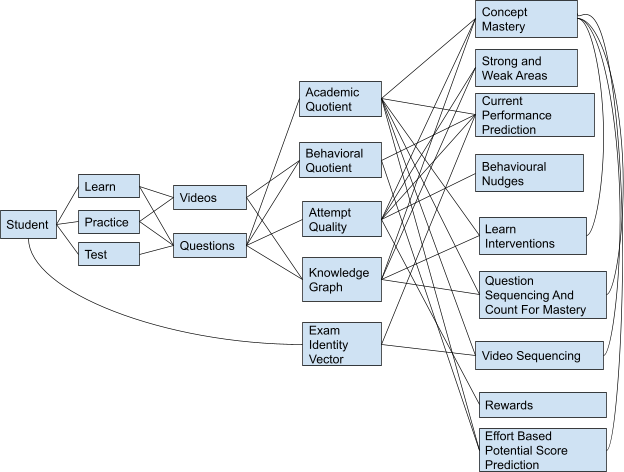The pedagogical choices of instructors in schools and colleges have largely driven student learning styles. Therefore, there is a range of learning styles for students. Felder-Silverman and Kolb’s learning styles are the two well-known frameworks that have a major influence on them and acted as the bedrock for Embibe’s digital learning platform and pedagogy.
What Are Learning Styles Anyways?
Learning styles proposed by Felder-Silverman are active-reflective, visual or verbal, sensing or intuitive and sequential or global, a highly personalized approach to learning. With a more process-oriented framework, Kolb defined stages of learning as active experimentation, concrete experience, reflective observation and abstract conceptualization. While the former’s classification is based on an individual’s personality traits, the latter highlighted the idea of experience-led knowledge construction split across stages of mastery.
What is Embibe Solving?
Embibe has built the student learning platform around two underlying ideas powering these frameworks using learning style examples: personalisation (Felder-Silverman) and learning outcomes (Kolb). The catch here is: for an instructor teaching a class of four-to-five students, intuition and real-time feedback through students’ physical and emotional responses can help pull off a relevant learning style; however, doing the same across 400 exams and millions of students, with age ranging between 10 years and 25 years, is the problem statement facing the Embibe AI and engineering teams.
Through the experiences of more than 500 domain experts and extensive user research surveys with over 2000 students across exams, we have identified that any student’s learning methodology is a combination of Felfer-Silverman’s styles. And students unable to maximize their potential were either not getting a suitable learning style or had a missing stage out of Kolb’s stages of mastery.
So, we zeroed in on two problem statements as a derivative of our objectives to deliver personalisation and learning outcomes, offering a range of features that cater to the range of learning styles and keeping track of the effort and performance at a very granular level to identify nudges for students to cross a stage of mastery.
How Does Embibe Offer Relevant Experiences for All Learning Styles?
There are primarily three loops of learning, where we deliver these styles activities for learning styles. The top loop includes learning, practice and test modules. The second loop includes the sequence and type of content served in these modules:
- Learn offers a range of video types, from 3D interactive concept explainers to whiteboard videos of top instructors solving complex problems step by step
- Practice takes care of serving questions and is augmented by learning interventions offering relevant videos and summaries to improve micro-level performance.
- The test includes pre-generated tests at exam levels and customized tests with an option to select a subset of the curriculum and difficulty level. As a feedback loop for a student’s current stage and future potential, the test module also includes exhaustive feedback that highlights a student’s skill readiness among Low-order-thinking-skills and High-order-thinking-skills, potential score on completing a journey on Embibe and granular details of weak and strong topics.
The innermost and third loop includes hints provided while solving a question, defined steps to solve a complex problem, and rewards for solving a question, discovering a feature, or reaching a milestone.
How Do We Make it a Truly Personalized Experience?
The data we capture while creating content and during student interactions with content is at the heart of the personalisation offered by Embibe, as it powers our predictive and adaptive learning algorithms, providing a highly engaging experience to students across exams and knowledge levels.
The most granular level of Embibe’s content platform is concepts, which are stored as a knowledge graph and connected across exams with a range of relationships to analyze the learning style theory. Higher-level entities include topics, a collection of concepts, and chapters, a collection of topics. A concept or a group of concepts act as an identifier for learning objects such as video, question and test.
As soon as a student interacts with a few learning objects, Embibe’s Bayesian Knowledge Tracing Algorithm predicts a value between 0 and 1 as the concept mastery level of the student across more than 93,659 concepts in Embibe’s knowledge graph.
These mastery values, along with a range of metadata, such as skill, bloom and difficulty, stored with each learning object, help us predict the probability of dropoff during a live session and offer relevant learning interventions through a learning-to-rank algorithm to fill knowledge gaps in real-time.
As the student interacts with more learning preferences and objects, specifically questions, we are able to come up with academic quotient and behavioural quotient vectors for each student. We also have a representation of each exam in the same high-dimensional space, derived across academic attributes using previous year exams. These vectors help us identify a student’s current acumen against any exam and the areas that require the most effort, this is a key offering in Embibe’s test feedback.
Embibe’s biggest differentiation in personalized experience comes from behavioural nudges at a user session granularity, during practice, video watching and test sessions, and at a global level. These nudges are powered by features we derive through each student and learn-object interaction, such as attempt quality, current mastery level and content metadata.
References:
[1] Sabine Graf, Silvia Rita Viola and Tommaso Leo, Kinshuk. “In-Depth Analysis of the Felder-Silverman Learning Style Dimensions.” Journal of Research on Technology in Education, 2007, 40(1), 79–93
[2] Doreen J. Gooden, Robert C. Preziosi, F. Barry Barnes. “An Examination Of Kolb’s Learning Style Inventory” American Journal of Business Education (AJBE) 2(3) DOI:10.19030/ajbe.v2i3.4049
[3] Cho, et al., “What is Bayesian Knowledge Tracing?”, Proceedings of the Workshop on Visualization for AI explainability (VISxAI), 2018.
[4] Keyur Faldu, Aditi Avasthi, and Achint Thomas. “Adaptive Learning Machine for Score Improvement and Parts Thereof.” US Patent No. 10854099 B2.
[5] Keyur Faldu, Aditi Avasthi, and Achint Thomas.“System and method for behavioral analysis and recommendations.” US20200312178A1.
[6] Keyur Faldu, Aditi Avasthi, and Achint Thomas. “System and method for recommending personalized content using contextualized knowledge base” US20200311152A1
[7] Lalwani, Amar, and Sweety Agrawal. “What Does Time Tell? Tracing the Forgetting Curve Using Deep Knowledge Tracing.” In International Conference on Artificial Intelligence in Education, pp. 158-162. Springer, Cham, 2019.


























